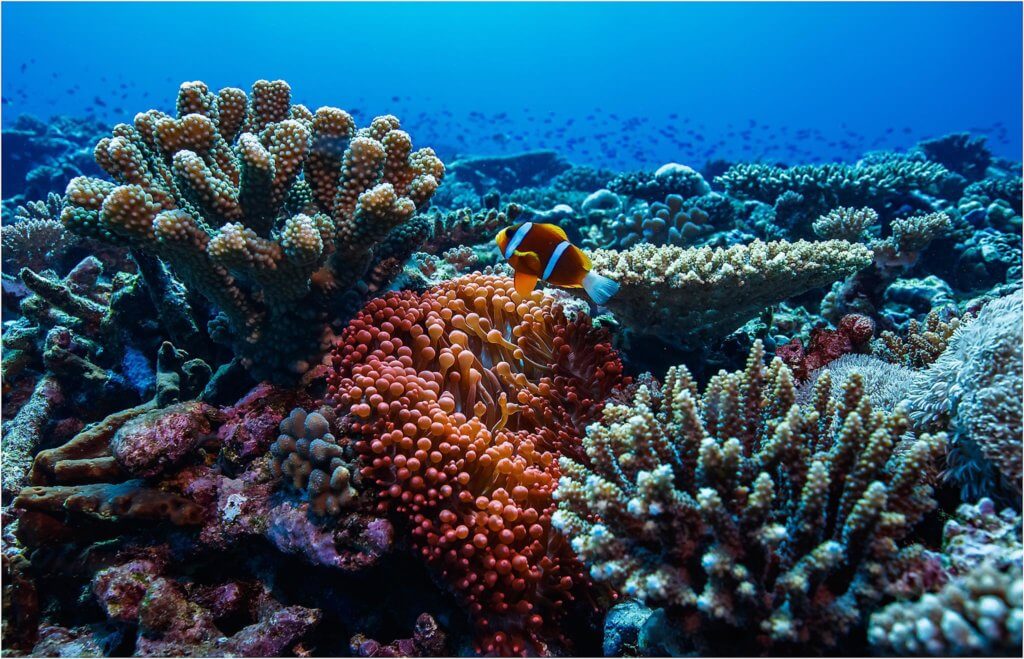Hi! I’m Jaimi the new Great Barrier Reef Water Quality Manager and Blue Carbon champion at the Australian Marine Conservation Society (AMCS).
I’m passionate about coastal wetlands and blue carbon and was thrilled this week when UNESCO released a report identifying Australia as a ‘hot spot’ for blue carbon.
Have you heard of blue carbon?
Blue carbon is a relatively new term that refers to the carbon stored in coastal ecosystems and includes mangroves, salt marshes and seagrasses. These ecosystems have stored carbon from the atmosphere and ocean and locked it away for thousands of years, helping to mitigate climate change.
The report identified three of Australia’s marine World Heritage Sites as among the world’s largest carbon stores. These three sites were:
- The Great Barrier Reef in Queensland
- Shark Bay in Western Australia and
- The Ningaloo coast in Western Australia

The Great Barrier Reef as been identified as a blue carbon ‘hot spot’ by UNESCO
These areas have an estimated 2bn tonnes of carbon dioxide locked away in seagrass meadows, coastal mangroves and salt marshes. In fact, almost 40% of all blue carbon is stored in all World Heritage sites.
My favourite part of the report states the Great Barrier Reef holds the greatest blue carbon stocks across all 50 world heritage marine sites.
According to the report, the Reef ecosystems store ~1.8bn tonnes of CO2 equivalent, with about 1.4bn tonnes stored in the 4.5m hectares of seagrass meadows, and the remaining carbon stored in the 207,000 hectares of mangroves and 186,000 hectares of salt marshes – wow!
While these ecosystems are healthy they can help store carbon dioxide for millennia. But when they are damaged they release carbon into the atmosphere and can contribute to global warming.
What worries me, is these ecosystems are under threat from climate change, human developments and poor water quality. We need to do more to protect them from damage and restore the ones that have been impacted.
Disastrous events such as marine heatwaves can kill off large areas of seagrass beds, release carbon and reduce food and habitat availability for our dugongs. Mangroves and salt marshes are continuing to be lost due to coastal development. Sea-level rise will further impact these ecosystems as they become ‘drowned’.
Loss of mangrove and salt marsh from coastal development directly impacts seagrass by reducing water quality and increasing nutrient loads into coastal estuaries, leading to a process known as eutrophication. This results in harmful algal blooms that smother seagrasses, creates dead zones and fish kills, which in turn worsens the impacts of climate change.
UNESCO identified Australia as a blue carbon hot spot!
3 of our World Heritage Sites are among the world’s largest carbon stores:
💜The Great Barrier Reef
💜Shark Bay &
💜NingalooWe must protect them & restore what’s already been impacted.https://t.co/J8EbrQplUd
— Fight For Our Reef (@FightForOurReef) March 8, 2021
What can you do to help restore blue carbon ecosystems?
Good question! The Australian Government is developing a carbon farming method through the Clean Energy Regulator. If you are a landowner, you can participate and have carbon credits generated for returning tidal waters onto lands, such as cane farms, and restoring mangroves and salt marshes.
What is AMCS doing?
AMCS and its supporters are calling for further investment in the conservation and restoration of the UNESCO marine World Heritage sites in the Great Barrier Reef, Shark Bay and Ningaloo-Exmouth Gulf catchment areas. In addition, we need the protection of existing blue carbon habitat, as a significant opportunity to mitigate climate change, improve biodiversity and water quality entering our precious Reefs. Head to our petitions page to take action now.
I hope you’ve learnt something about the amazing benefits our blue carbon ecosystem can provide!